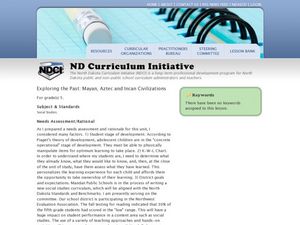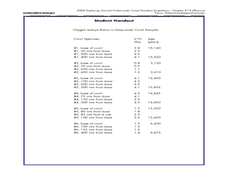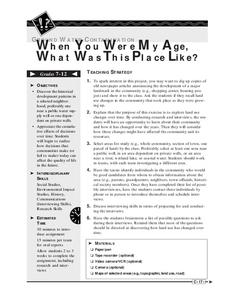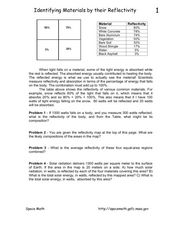Curated OER
MATH SHAPES
First graders identify the given math shape and then click and drag the shape name to the correct shape.
Curated OER
Exploring the Past: Mayan, Aztec, and Incan Civilizations
Fifth graders research the Mayan, Aztec, and Incan Civilizations and identify contributions they made to modern society. In this ancient civilizations lesson plan, 5th graders look at maps of where they were located.
Curated OER
Addition and Subtraction of Polynomials
For this polynomial worksheet, students add and subtract polynomials by identifying and collecting like terms. Twenty problems are provided on this two-page worksheet.
Curated OER
Adding and Subtracting Polynomials
In this polynomials worksheet, 9th graders solve and complete 12 different problems that include adding and subtracting. First, they identify and combine like terms. Then, students find each sum or difference using the appropriate...
Curated OER
Looks Like Respect, Sounds Like Respect, Feels Like
Students explore philanthropy through art. In this service learning lesson plan, students discuss the diversity in their community and use their senses to create tolerance posters.
Curated OER
How can deep-water corals be used to determine long-term patterns of climate change?
Students explore the concept of paleoclimatological proxies. For this paleoclimatological proxies lesson, students explain isotope ratios in deep water coral samples. Students write a paragraph about global climate change as...
Curated OER
When You Were My Age, What Was This Place Like?
Students discover how land use in their community has changed. In this community and ecology lesson, students scan old newspapers to find articles about the development of community land. Students discuss and predict how land use has...
Curated OER
Identifying Materials by their Reflectivity
In this reflectivity worksheet, students read about the absorption and reflectivity of light by different materials. Students solve 4 problems and determine the composition of given materials based on the amount of light reflected. They...
Curated OER
What Do Genes Look Like?
Seventh graders describe the basic structure of the DNA molecule. They identify what an inherited trait is and how it can be determined by one or more genes. Finally, 7th graders identify that plant and animal cells contain several...
Curated OER
Medical Terms
In this medical terms worksheet, students identify and locate various vocabulary terms related to medicine. There are 50 biology terms located in the word search.
Curated OER
Looking into Careers: Doing What I Like and Liking What I Do
Students explore careers. In this service learning lesson, students consider the value of job satisfaction and explore non-traditional jobs related to animal welfare.
Curated OER
Word Search and Define – Lesson 2
In this health worksheet, students identify and locate eight vocabulary terms in the puzzle and then, they fill-in the blanks to the correct description of each.
Curated OER
1-5: Distributive Property
In this distributive property worksheet, students solve 9 multiple choice and short answer problems. Students use the distributive property to simplify expressions.
Curated OER
A Feature Presentation - Geographic Landforms
Students investigate, identify and compare the various geographic terms that can be used to describe the landforms occurring in the Hawaiian islands.
Curated OER
Lots of Lessons from Aesop
Aesop’s Fables offer young learners an opportunity to study figurative language. After reviewing theme, simile, alliteration, and metaphor, model for your pupils how to identify examples of these devices in the fable. Class members then...
Curated OER
A Matter of Survival
Fourth graders dance with inspiration from wild animals. In this creative movement lesson, 4th graders watch a video clip and then move like an animal might move in their natural surroundings.
Curated OER
Figurative Language: Similes
How does one identify a simile, and why is it important to understand what they are? Here's a very basic review. This short presentation defines the term, provides examples, and gives learners a chance to identify which two things are...
Curated OER
Life Science: Living Things
Have your class build their vocabulary bank by studying life science terms. Basic terms like organism, cell, unicellular, and vertebrate are included on the definition sheet provided. Demonstrate how to identify different life science...
Shmoop
ELA - Literacy.CCSS.ELA-Literacy.RST.9-10.6
Key to understanding scientific or technical texts is identifying the underlying question the author is attempting to answer. Provide your young scientists with an opportunity to practice identifying these questions and the procedures...
Curated OER
The Boy Who Cried Wolf
Second graders listen to the story, THE BOY WHO CRIED WOLF and in pairs, discuss the theme of the book and two things that they liked about it. They then read the book OOPS and discuss the theme of the book identifying the things they...
Curated OER
Chemistry: Section Review
Review the 5 branches of chemistry and related terms with this worksheet. The focus of these activities is on terms and definitions. Learners answer questions about the study of chemistry, reasons to study chemistry, and pure and applied...
Curated OER
Unit: Processing and Manufacturing: Examination Three
StudentsMatch the vocabulary terms in column A with the definitions in column B. Write the letter of the definition in column B in the space next to the terms in column A. Afterwhcich, students Write short answers or fill in the blank to...
Curated OER
Chivalry: Dead or Alive?
Learners identify behaviors which may be considered chivalrous and provide a definition of what chivalry entails. They articulate their views about chivalrous behavior identify times in which they have acted in a chivalrous manner.and...
Curated OER
Prairie Find Outdoors
Students take a field trip to a local prairie. Using identification books, they identify various forbs and grasses in the prairie. As a class, they discuss the importance of forbs and grasses to the ecosystem and review the various types...























